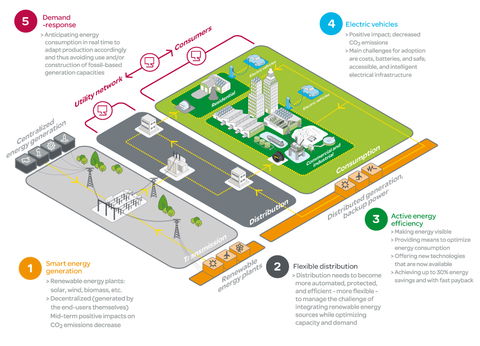Behind the scenes, there is an infrastructure energy revolution taking place. This is crucial to being able to cope with increasingly complex demands from smart homes and building automation to local power generation like solar PV. Barrie Cressey, Smart Grids Director at Schneider Electric, explains:

Demand, and especially peak demand, for electricity is on an upward trajectory. The unrelenting drive to connect people with devices and machines is ushering in automation to every industry and the home. This ability to automate and connect is changing energy dynamics and highlighting constraints in electricity infrastructure, from generation and transmission to distribution.
Subsequently, the need for a smarter, connected, more efficient and digitally active energy approach has never been more apparent.
The UK is witnessing an energy evolution. The electricity network was designed to be one-dimensional - to transmit power from vast facilities to major load centres via high capacity power lines out to sub-networks and then on to industry and consumers.
However, with more intense pressure on capacity, there is a need for the network to be multi-directional and intelligent. This has brought about the advent of the smart grid - the ability to use digital communications to detect and react to local changes in usage as part of a smarter energy strategy.
Giving energy back
Imperial College has said that the UK should have ten million homes with solar panels by 2020 if it is to fulfil its renewable energy potential. This means that Britain could get as much as six per cent of annual electricity needs from solar power according to its estimates.
Those households having solar PV panels will be able to feed excess energy back into the smart grid for cash benefits. Furthermore, it has the potential to transform disinterested consumers of energy into active participants in energy decisions.
As efforts to find renewable means of generating that power increase, getting that power from A to B without major changes to the current system becomes increasingly complex. With classic grids, if a local sub-network generated more power than it was consuming, for example a house with solar PV panels, the reverse flow could raise safety and reliability issues. A smart grid aims to manage such situations.
Enabling the smart energy revolution
In a smart grid scenario, sensors can indicate which surges and losses may be dangerous, especially when parts of the distribution network are under stress, and determine and automate the best response. As a result, power can be rerouted to customers in a matter of seconds, or perhaps even milliseconds, whilst safety is maintained. It is this ability to react quickly and intelligently that enables blackouts to be avoided and ensures continuity and availability of power to consumers.
The digitisation and synchronisation of disparate technologies within the energy infrastructure will be critical if the UK is to overcome one of the biggest inhibitors to the smart energy revolution – a legacy network.
At present, the UK is preparing to roll-out smart meters to every home to provide real-time data to energy suppliers and empower consumers to make better energy choices. Behind the scenes, there is an infrastructure energy revolution taking place. It is one that is critical to driving the UK towards a better energy future.
